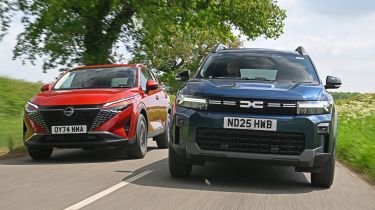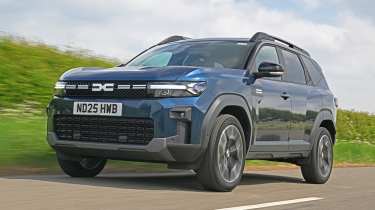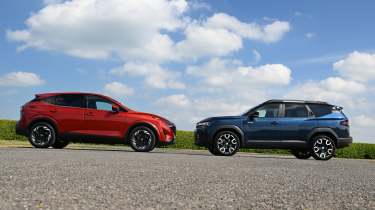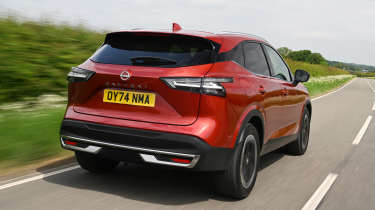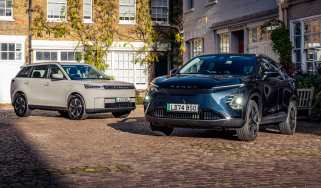Nissan Qashqai vs Dacia Bigster: big-selling SUV faces a brand-new threat
The Bigster is Dacia’s largest model yet. How does it compare with the ever-popular Nissan Qashqai?
With the lower end of the market covered by the likes of the Sandero supermini, Jogger seven-seater and Spring electric city car, the only way was up for the expansion of Dacia’s range. Enter the Dacia Bigster compact SUV, a model with a name that neatly describes its position: it’s like a Duster, but bigger.
But there’s a bit more to it than simply larger dimensions and more space, because this is also the first model from the Renault Group to use its new 1.8-litre hybrid powertrain. It’s the most expensive Dacia yet, too, although a maximum price tag of £30,000 means the Bigster offers more space and kit than many other cars in the same bracket.
To see exactly how the Bigster fits into the market, for this test we’re pitching it against one of the UK’s best-selling compact SUVs, the Nissan Qashqai. As it stands, Qashqai prices start pretty much where the Bigster’s stop, so we want to see if you get what you pay for.
Does the Romanian newcomer offer the complete package of family-friendly practicality, low running costs and head-turning style? Or does paying a little extra reap the benefits of a more rounded and upmarket ownership experience?
Dacia Bigster
| Model: | Dacia Bigster Journey Hybrid |
| Price: | £29,440 |
| Powertrain: | 1.8-litre 4cyl petrol hybrid, 153bhp, six-speed auto/fwd |
| 0-62mph: | 9.7 seconds |
| Test efficiency: | 53.7mpg |
| Annual VED: | £195 |
Like for like, the Dacia Bigster is around £3,500 more than the Duster, but that means prices are still well under those of compact SUVs that are a similar size. There’s a 1.2 TCe mild-hybrid version available with two or four-wheel drive, but we’re testing the new 1.8 hybrid powertrain. Expression, Journey and Extreme trims are available, but even the top-spec Extreme hybrid comes in at less than £30,000. We’re testing the comfort-orientated Journey model, which offers plenty of kit and is £29,440 in hybrid guise.
Used - available now

2023 Audi
Q3
56,069 milesAutomaticPetrol1.5L
Cash £18,713
2022 Volvo
XC40 Recharge
33,964 milesAutomaticElectric
Cash £24,940
2022 Volvo
XC40
25,494 milesAutomaticPetrol1.5L
Cash £24,091
2024 Volvo
XC60
15,621 milesAutomaticPetrol2.0L
Cash £40,791Tester’s notes
The new hybrid powertrain works well in the Bigster. While there’s a larger-capacity petrol engine under the bonnet, the car still favours electric drive most of the time, especially at lower speeds.
The benefits can also be felt at higher speeds, though, and the electronics swap between the engine and electric motor where necessary, with one taking a load off the other and vice versa. We’d like to see some sort of multi-stage energy recuperation, though, because the single ‘B’ mode that’s offered isn’t very strong.
If you want to make the most of the Bigster’s improved cabin space over the Duster, then we’d recommend investing in the Sleep Pack. This simple camping kit costs £1,740 and adds a plywood box that contains a rolled-up mattress and blackout window blinds.
Simply open the box and fold the back seats, roll out the mattress and fit the window blinds, and you have yourself a car-shaped sleeping area. For £2,090 you can even get the Sleep Pack with a tailgate tent, too.
Nissan Qashqai
| Model: | Nissan Qashqai Acenta Premium MHEV |
| Price: | £31,335 |
| Powertrain: | 1.3-litre 4cyl petrol MHEV, 156bhp, six-speed manual/fwd |
| 0-62mph: | 9.5 seconds |
| Test efficiency: | 37.4mpg |
| Annual VED: | £195 |
The Nissan Qashqai remains a hugely popular choice among buyers in the UK, so it’s a perfect benchmark for the Bigster. While the model in our pictures is the N-Connecta – our pick of the range in terms of the balance it offers between price and standard equipment – the figures you’ll see in the specifications are for the model which is more closely aligned with the Dacia’s price: the base-spec Acenta Premium. In this trim and with the mild-hybrid manual powertrain, it’s priced at £31,335.
Tester’s notes
The Qashqai’s steering remains fairly relaxed on the move, so it’s a car that doesn’t need too many corrections to the wheel to keep things on the right track. Of course, this can be made even more relaxing with the on-board driver-assist technology. All but the base trim come with not only adaptive cruise control, but self-steering tech, too.
This can keep the car positioned neatly within a lane for short periods at a time, and it really helps to take the strain out of longer journeys.
While the entry-level Acenta Premium is closest to the Bigster in price, Qashqai buyers have four more trim levels to work through. The N-Connecta in our images sees the wheel size grow from 17 to 18 inches, adds built-in Google tech and wireless smartphone charging, and gets a surround-view monitor in place of a reversing camera. It’s £2,470 more expensive than the base model, though.
The top-spec Tekna+ gets 20-inch wheels, a panoramic roof and a sophisticated multi-link rear suspension layout.
Head to head
On the road
Neither car is particularly fast, but the Nissan feels more responsive, thanks to its revvy petrol engine and manual gearbox. The Dacia favours electric drive, so it picks up quickly, but there’s a disconnect between your acceleration and the sound of the engine. The Bigster has a fidgety ride at low speeds that improves the faster you go, but overall the Qashqai on its smaller wheels feels more comfortable.
Tech highlights
The high-spec Bigster has the measure of the entry-level Qashqai for kit. The touchscreen systems both run Google software, but the Dacia’s black screens with green highlights have a more modern look. While the Qashqai has a reversing camera, the Bigster features front and rear cameras, plus a forward-facing side view from cameras in the door mirrors that can help you position the front wheels.
Price and running
Claimed fuel economy of 58mpg for the Bigster hybrid is well ahead of the petrol manual Nissan, and it proved to be an efficient performer on test, too. We saw more than 53mpg without even trying to drive efficiently, and the powertrain’s EV bias will only improve on that with more urban driving. The Nissan was decent, at 37.4mpg in similar driving, but mild-hybrid tech isn’t a match for a full hybrid.
Practicality
Dacia is a clear winner here for boot space, but it is 145mm longer than its rival, so we’d expect it to hold an advantage. In terms of interior room, both are very generously appointed and great for families. Choose your models carefully if you plan to tow; the Qashqai MHEV is the best with a 1,650kg limit to the Bigster’s 1,500kg, but full-hybrid versions only manage 1,000kg (Dacia) and 750kg (Nissan).
Safety
The Qashqai earned a five-star Euro NCAP rating in 2021, with a notably strong 95 per cent score for its on-board safety tech. While Dacia’s models haven’t fared very well in the safety organisation’s tests, at least the Bigster has a decent list of safety kit. One highlight is the My Safety system, which allows you to set up the likes of lane assist and traffic-sign recognition to your preference at two touches of a button.
Ownership
Both cars come with a fairly average three-year/60,000-mile warranty, plus breakdown cover for the same period. But the Bigster edges ahead for warranty cover with the Dacia Zen package. If you get the car serviced at an official Dacia franchise, then it is automatically entitled to 12 months or 18,000 miles of warranty cover, and you can cover the vehicle up to its seventh birthday or for up to 75,000 miles.
Verdict
Winner: Dacia Bigster
The Dacia Bigster takes the popular Duster’s attractive formula of chunky design and user-friendly features and introduces lots more space, but there’s only a relatively modest increase in price. The new hybrid powertrain works well in this application, too, delivering impressive fuel economy for the Bigster’s size and decent responses.
Cabin quality is a bit patchy in places, while the ride on larger wheels is a little fidgety, but we don’t consider these factors to be deal breakers when you consider how much car and equipment you’re getting for a price lower than that of an entry-level competitor.
Runner-up: Nissan Qashqai
There’s plenty to like about the Nissan Qashqai, but it doesn’t pull out enough of an advantage over the Dacia Bigster to make it our preferred choice. While the Qashqai feels more grown up and comfortable to drive, as everyday family transport, there isn’t as much space inside, especially in the boot, while the amount of kit you get isn’t comparable, and what you do get is starting to feel a little dated.
The mild-hybrid petrol powertrain offered at this price isn’t engaging enough to counter its relative lack of efficiency when compared with its full-hybrid Romanian rival, either.
Prices and specs
| Dacia Bigster | Nissan Qashqai | |
| Our choice | Dacia Bigster Journey Hybrid | Qashqai Acenta Premium MHEV |
| Price from/price of our choice | £29,440/£29,440 | £31,335/£31,335 |
| Powertrain and performance | ||
| Engine | 4cyl in-line hybrid/1,793cc | 4cyl in-line mild hybrid/1,332cc |
| HEV motor | 50bhp | 19Nm |
| Power | 153bhp | 156bhp |
| Torque | 205Nm | 260Nm (petrol/electric) |
| Transmission | Six-speed auto/fwd | Six-speed manual/fwd |
| 0-62mph/top speed | 9.7 seconds/112mph | 9.5 seconds/128mph |
| Fuel tank/battery capacity | 50 litres/1.4kWh | 55 litres/0.12kWh |
| MPG (WLTP/test)/range | 58.0/53.7mpg/591 miles | 44.1/37.4mpg/452 miles |
| CO2 | 105g/km | 143g/km |
| Dimensions | ||
| Length/wheelbase | 4,570/2,702mm | 4,425/2,665mm |
| Width/height | 1,812/1,711mm | 1,835/1,625mm |
| Rear kneeroom | 635-850mm | 601-844mm |
| Rear headroom/elbow room | 1,025/1,440mm | 922/1,451mm |
| Boot space (seats up/down) | 612/1,977 litres | 504/1,447 litres |
| Boot length/width | 1,055/1,005mm | 855/1,084mm |
| Boot lip height | 725mm | 756mm |
| Kerbweight/ towing weight | 1,419/1,000kg | 1,347/1,650kg |
| Turning circle | 11.0 metres | 11.1 metres |
| Costs/ownership | ||
| Residual value (after 3yrs/36,000 miles) | £19,124/64.96% | £15,599/49.78% |
| Depreciation | £10,316 | £15,736 |
| Ins. group/quote/VED | 28/£691/£195 | 21/£635/£195 |
| Three-year service cost | £360 | £825 |
| Annual tax liability std/higher rate | £1,566/£3,131 | £2,077/£4,153 |
| Annual fuel cost (10k miles) | £1,123 | £1,612 |
| Basic warranty/recovery | 3yrs (60,000)/3yrs | 3yrs (60,000)/3yrs |
| Driver Power manufacturer position | 22nd | 15th |
| Euro NCAP Adult/child/ped./assist/stars | 69/85/60/57/3 stars (2024*) based on Duster | 91/91/70/95/5 stars (2021) |
| Equipment | ||
| Metallic paint/wheel size | £650/19 inches | £745/17 inches |
| Parking sensors/camera | Front & rear/front & rear | Rear/rear |
| Spare wheel/Isofix points | £300/two | Repair kit/two |
| Keyless entry & go/powered tailgate | Yes/yes | Yes/no |
| Leather/heated seats | No/yes | No/no |
| Screen size/digital dashboard | 10.1 inches/yes | 12.3 inches/yes |
| Climate control/panoramic sunroof | Yes/£500 | Yes/no |
| USBs/wireless charging | Four/yes | Four/no |
| Wireless CarPlay/Android Auto | Yes/yes | Yes/yes |
| Blind-spot warning/head-up display | Yes/no | Yes/no |
| Adaptive cruise/steering assist | Yes/no | Yes/no |
What we would choose
Dacia
For £300 you can add a space-saver spare wheel. The only other option of note beyond metallic paint (£650) and a contrast roof colour (another £650) is a panoramic sunroof (£500), which is only offered on Journey trim.
Nissan
If you want more kit on your Qashqai, you must fork out for a posher trim level. There are eight exterior colours to choose from, while a contrasting black roof is offered on N-Design, Tekna and Tekna+ models.
Our dealer network has 1,000s of great value new cars in stock and available now right across the UK. Find your new car…

